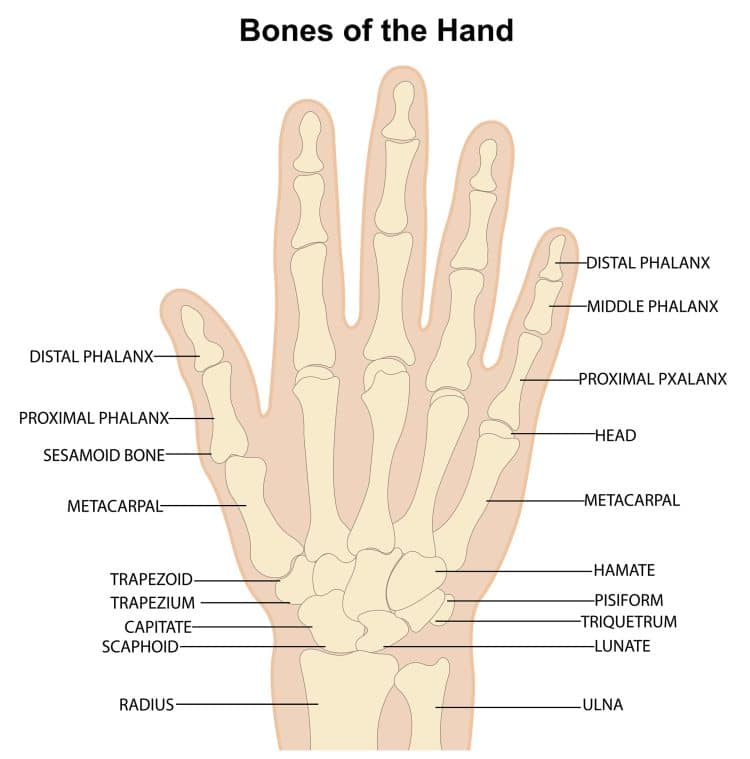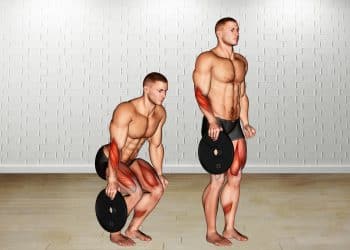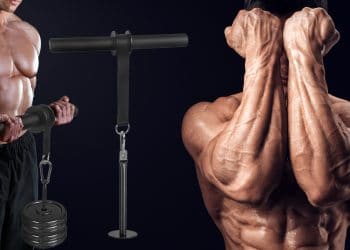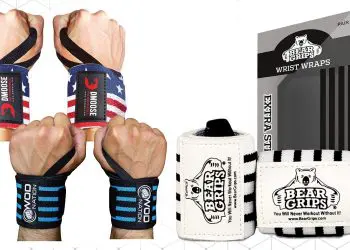Are you self-conscious about having slender wrists? Are you concerned that having thin wrists affects your aesthetics? Do you think thicker wrists will improve your athletic performance, e.g., arm wrestling or baseball? Do you worry that a large watch could look out of place on your thin wrists?
These are all valid concerns.
Unfortunately, there is a lot of misinformation about wrist size and how to increase it, which can lead to a lot of frustration and wasted time and energy. That’s because your wrists are mostly made up of bones and not muscles. As such, once you’ve finished growing, there is not a lot you can do to make your wrists thicker.
But all is not lost because you can definitely make your wrists stronger, and that’s far more beneficial.
In this article, we delve into the hot topic of building bigger wrists, revealing what you can do about your small wrist size.
Genetic and Environmental Factors Affecting Wrist Size
Your wrist size, like the color of your eyes, the size of your feet, and your height, is primarily determined by your genetics. Genetics describes how your genes express themselves and is like the blueprint for a building. Your genes determine the shape, structure, and function of your body, and, currently, your genes are unmodifiable.
Level Up Your Fitness: Join our 💪 strong community in Fitness Volt Newsletter. Get daily inspiration, expert-backed workouts, nutrition tips, the latest in strength sports, and the support you need to reach your goals. Subscribe for free!
Returning to our building analogy, you can’t change the plans for your building part-way through construction. However, there are things you can do to ensure you make the most of the genetic cards you’ve been dealt – more on that later.
Now that we’ve set the stage, let’s delve into the factors – both genetic and environmental – that determine wrist size.
Bone Structure

The wrist is made up of several bones. This includes the ulna and radius of the forearm and the carpal bones, specifically the lunate and scaphoid. These bones determine wrist size. While, like all bones, these structures get stronger and more dense in response to weight-bearing activity, once your bones are fully grown, they have very little capacity for getting bigger. This is why exercise won’t have much impact on wrist size.
Some people are blessed with thick wrist bones, while others have much more slender wrists. If you are unhappy with your wrist size, you should blame your ancestors, as genes are inherited from previous generations of your family. If you have slim wrists, it’s safe to say other members of your family tree probably do, too.
Connective Tissue Thickness
While your wrist is mostly a group of bones that come together to form a joint, it’s connective tissue like ligaments and tendons that hold those bones together. Ligaments and tendons are immensely strong, can be strap or cord-like, are non-contractile, and have a relatively poor blood supply. Where ligaments attach bone to bone, tendons attach muscle to bone.
Connective tissue thickness, like bone thickness, is mainly genetic. These structures do not grow like muscles, although, with appropriate exercise, you can make them stronger. They may thicken in response to stress, e.g., doing manual labor, but increases in size are marginal at best.
However, despite their inability to grow, connective tissue thickness still contributes to wrist size.
Fat Mass
While fat mainly accumulates around more obvious areas of your body, such as your waist, thighs, or next, it can also build up around your wrists. This is especially true if you are obese, i.e., carrying a large amount of excess fat. As such, gaining fat may increase your wrist circumference, while losing it could make your wrists smaller.
Edema
Edema, or fluid retention, can temporarily increase wrist circumference by causing swelling in the wrist area. This condition can distort measurements and give the appearance of a larger wrist size. Still, it’s important to note that this does not indicate actual bone or muscle growth. Edema can occur due to injury, e.g., a sprain or an underlying medical condition, such as congestive heart failure, kidney disease, or liver cirrhosis.
Activity Levels During Your Formative Years
Your body is very adaptable, and that’s especially true during your formative years, i.e., when you are growing. So, if you were sedentary or did a lot of activities that didn’t really stress your wrists, they didn’t have a reason to grow thick and strong.
For example, if you grew up doing lots of running or cycling, your wrists wouldn’t be as big as they might have been if you’d done more weightlifting, gymnastics, or rock climbing, which put a lot of stress on the wrist joints.
Diet During Your Formative Years
It’s often said you are what you eat, and that’s especially true as you grow toward physical maturity. Bones need vitamins, minerals, protein, and calories to grow, as does the rest of your body. If you suffered malnutrition in your youth, your skeleton might not have developed fully, and that includes wrist bone thickness.
Medical History
There are several diseases and conditions that can affect bone growth and, as such, could have an impact on your wrist size. Examples include hypothyroidism, rickets, growth hormone deficiency, and juvenile rheumatoid arthritis. In addition, repeated wrist fractures and subsequent joint immobilization for healing can also cause slimmer wrists.
Gender
Because of the hormone testosterone, men tend to have thicker bones and greater bone mass than women (1). However, a large-framed woman could have thicker wrists than a slender-framed man, so comparing wrist sizes between genders may not be very useful.
Ethnicity
Your ethnicity can also affect your wrist size. For example, people of Asian origins often have smaller, lighter bones than Caucasians and African/African American populations (1). Of course, there is also variance within each ethnic group, so this is only a general observation and may not apply to individuals. Genetic factors, lifestyle, and environmental conditions can all contribute to variations within these groups.
Age
Bone density tends to decrease with age, a process called osteopenia. This occurs when the rate of bone breakdown and absorption outpaces bone remodeling and repair. As such, thinner wrists could be attributed to getting older (3). However, a healthy diet and appropriate workout routine can minimize this effect.
Additional Lifestyle Factors
Smoking and drinking alcohol to excess can limit bone growth and could speed up bone loss. Subsequently, this could affect wrist thickness, especially if these lifestyle factors occurred during the formative years when most bone growth occurs.
Now that you understand what determines the size of your wrists, let’s move on to how you can measure them and see how your results compare.
Measuring Your Wrist Size

So, how do you know you’ve got slender wrists? One of the simplest ways is to wrap the fingers of one hand around your opposite wrist. You have relatively big wrists if your thumb and finger don’t touch. On the other hand, overlapping fingers indicate a small wrist, and you have average-sized wrists if your index finger and thumb touch slightly.
This method doesn’t account for your hand size, so it is not the most reliable. But it’s a good place to start for a quick and easy self-assessment.
However, if you want a more precise wrist size measurement, you’ll need to use a tape measure. Follow these steps to get an accurate result you can compare to the normative charts provided below:
Step 1: Get Your Supplies Ready
Before you begin, ensure you have a flexible tape measure, a pen, and paper. If you’re doing this alone, a mirror can also be helpful to ensure you’re measuring the right spot.
Step 2: Position Your Arm
Extend your arm forward so that it’s parallel to the ground. Make sure your wrist is in a neutral position, not flexed or extended.
Step 3: Locate the Measuring Point
Find the narrowest part of your wrist, usually just above the wrist bone. This is where you’ll wrap the tape measure.
Step 4: Wrap the Tape Measure
Carefully wrap the tape measure around your wrist at the point you’ve identified. Make sure it’s snug but not tight—you should be able to slip a finger underneath the tape.
Step 5: Take the Measurement
Read the number where the tape measure meets the zero end. This is your wrist circumference. If you’re using a mirror, make sure the tape is level to get an accurate reading.
Step 6: Record the Measurement
Write down the measurement in inches or centimeters, depending on your preference. It’s a good idea to take a couple of measurements to ensure accuracy.
Step 7: Interpret Your Results
Now that you have your wrist circumference, you can compare it to the average wrist size for your gender and age (2, 3).
Average Wrist Circumference by Age and Gender
| Average Wrist Circumference by Age and Gender | ||||
| Age | Men (inches) | Men (cm) | Women (inches) | Women (cm) |
| 18-24 | 7.1 | 18.0 | 6.4 | 16.3 |
| 25-34 | 7.2 | 18.3 | 6.5 | 16.5 |
| 35-44 | 7.3 | 18.5 | 6.6 | 16.8 |
| 45-54 | 7.4 | 18.8 | 6.7 | 17.0 |
| 55-64 | 7.5 | 19.1 | 6.8 | 17.3 |
| 65-74 | 7.6 | 19.3 | 6.9 | 17.5 |
Small, Medium, Large Wrist Size Male & Female
| Wrist Size | Male | Female |
| Small | 6-6.7″ (15.2-17 cm) | 5.3-5.8″ (13.5-14.7 cm) |
| Medium | 6.7-7″ (17-17.8 cm) | 5.8-6.1″ (14.7-15.5 cm) |
| Large | 7-7.7″ (17.8-19.6 cm) | 6.1-6.9″ (15.5-17.5 cm) |
Read more about how to measure your wrists and average wrist size in this detailed article.
Now that you have a better understanding of how to measure your wrist size and where you stand compared to the average, let’s dive into the next section and explore whether you can actually increase your wrist size.
Can You Actually Increase Wrist Size?
If you’ve arrived at this section hoping to discover the secrets to building thicker wrists, we’ve got bad news: your wrist size is largely unmodifiable.
In fact, your wrist size is determined mainly by bone thickness, and that won’t change much once you are an adult.
You can make your wrists thicker by gaining fat, but needless to say, that’s not generally recommended. In addition, doing wrist strengthening exercises could also increase wrist size. However, any changes will be negligible at best. This is because there are no muscles in the wrist, and the connective tissues that cross your wrists have very little potential for growth.
So, while you won’t be able to make your wrists bigger, at least by much, the good news is you can make them considerably stronger and more stable. That’s because the muscles that control your wrists, i.e., your forearms, are highly trainable.
In the next section, we reveal the best exercises for increasing wrist strength and forearm size.
Exercises to Increase Wrist Strength and Forearm Size
While you can’t do much about the size of your wrists, you can make them stronger and more stable. You can also beef up your wrist’s closest cousin – your forearm. These are some of the best exercises for these purposes.
1. Wrist Curls
Muscles targeted: Forearm flexors.
Level Up Your Fitness: Join our 💪 strong community in Fitness Volt Newsletter. Get daily inspiration, expert-backed workouts, nutrition tips, the latest in strength sports, and the support you need to reach your goals. Subscribe for free!
Despite the promising name, wrist curls won’t do much for the size of your wrists. However, they’re an excellent exercise for increasing inner forearm mass. If you’ve ever dreamed of having bowling-pin lower arms, this is the exercise you want. However, make sure you balance up your forearm development by including wrist extensions in your forearm workouts – exercise #2.
Steps:
- Sit on the end of an exercise bench and rest your forearms on the edge, palms facing up. Hold a barbell in your hands.
- Extend your wrists and lower the weight down toward the floor. Keep your forearms and elbows flat on the bench.
- Flex your wrists and raise the weight back up.
- Alternate between these two positions for the desired number of reps.
Tips:
- Open your fingers and let them unroll to strengthen your hands as well as your forearms.
- Take care not to hyperextend your wrists, which could lead to injury.
- You can also do this exercise with your forearms resting on your legs.
2. Wrist Extensions
Muscles targeted: Forearm extensors.
Wrist extensions, also known as reverse wrist curls, work the tops of your forearms. These muscles are often neglected and underdeveloped. Building your forearm extensors will add a lot of size to your lower arms and increase your grip strength.
Steps:
- Sit on an exercise bench with your legs bent and feet flat. Rest the underside of your forearms on your legs so your palms face down. Hold a dumbbell in your hands.
- Flex your wrists and lower the weight down toward the floor.
- Next, extend your wrists and bend them back to raise the weight.
- Alternate between these two positions for the desired number of reps.
Tips:
- You can also do this exercise with a dumbbell or dumbbells if preferred.
- Rest your forearms on a bench instead of your legs if you wish.
- Use a false or thumbless grip to increase forearm engagement.
3. Hammer Curls
Muscles targeted: Brachioradialis, Biceps brachii and Brachialis
The great thing about hammer curls is that they work your upper and lower arms at the same time. This makes them a very time-efficient and effective exercise for improving total arm size and function. So, if you want the most bang for your buck, make hammer curls part of your workouts.
Steps:
- Sit or stand with a dumbbell in each hand, arms by your sides, and palms facing your legs.
- Bend your arms and curl the weights up to your shoulders. Do not rotate your wrists. Instead, keep your hands neutral.
- Lower the weights and repeat.
Tips:
- Keep your upper arms tucked into your sides.
- Do not use your legs or back to help you lift the weight. Your torso should remain stationary.
- You can also do this exercise with a cable machine and rope handle.
4. Knuckle Push-Ups
Muscles targeted: Pectoralis major, deltoids, triceps brachii, forearm flexors/extensors and core
Push-ups might seem like an odd exercise to include in a list of forearm/wrist exercises. Still, this variation is very good for developing wrist stability. It’s popular among martial artists who value it for making strong, injury-proof wrists for punching and grappling.
Steps:
- Kneel on the floor, clench your fists, and rest your knuckles on the floor so your wrists are straight and about shoulder-width apart. Use a neutral hand placement, i.e., palms turned inward.
- Walk your feet out and back into the push-up position.
- Bend your arms and lower your chest to within an inch of the floor.
- Push yourself back up and repeat.
Tips:
- Bend your legs and rest on your knees to make this exercise easier.
- Wear a weighted vest to make knuckle push-ups more challenging.
- For comfort, do this exercise on a mat, but be aware that it may make your wrists more unstable and more difficult.
5. Farmer’s Walk
Muscles targeted: Forearms flexors, core, trapezius & lower body.
The farmer’s walk is a very functional forearm and grip exercise. After all, walking while carrying a heavy weight is something many people do quite regularly. As well as working your lower arms, this is an excellent trapezius and core exercise, and it’s good for general conditioning, too.
Steps:
- Hold a heavy dumbbell in each hand, arms by your sides, and palms turned inward. Pull your shoulders down and back, and brace your core.
- Without bending your elbows, go for a walk around your training area. Continue until you feel your grip starting to fail.
- Place the dumbbells on the floor, rest for a moment, and repeat.
Tips:
- Do this exercise with one dumbbell to increase core engagement. Swap sides set by set.
- You can also use kettlebells for farmer’s walks, which usually have thicker handles to make the exercise more demanding.
- Use lifting chalk to stop your hands from slipping.
6. Dead Hang
Muscles targeted: Forearm flexors, biceps brachii, trapezius, latissimus dorsi & core.
Grip and forearm exercises don’t come much more straightforward than dead hangs. But don’t let this simplicity fool you; this is a challenging and effective exercise. Dead hangs are also a great way to decompress your spine and stretch your lats. Make it even harder by using a thick or spinning bar.
Steps:
- Grip and overhead bar with an overhand, shoulder-width grip. Hang from the bar with your core braced, shoulders down and back, and feet off the floor.
- Hang for as long as possible.
- Do not hold your breath, as doing so could make you feel faint and elevate your blood pressure.
Tips:
- Chalk your hands to prevent slipping.
- Strong people can also do this exercise one-handed.
- Use a false/thumbless grip to make dead hangs harder.
7. Hand Grippers
Muscles targeted: Forearm flexors.
The great thing about hand grippers is they’re portable, so you can use them almost anywhere and anytime. This means they are all but excuse-proof, so there is no reason you can’t develop stronger hands and more muscular forearms. Buy several hand grippers, from light tension to heavy-duty, so you can vary the intensity of your grip workouts. 50, 100, 150, and 200 pounds is a good range that should be suitable for most people.
Steps:
- Select the appropriate strength gripper.
- Place the bottom handle at 45 degrees in your palm. The device should be placed just above the base of your thumb.
- Place your pinky, ring, middle, and index fingers as low on the top hand as possible.
- Slowly squeeze the handles until they are in contact with each other.
- Return to the starting position in a slow and controlled motion.
- Continue for the desired number of reps.
Tips:
- Do a mixture of low, hard reps and higher, easier reps to develop forearm strength and size.
- Do not use your grippers too often, or you may develop overuse injuries. Every other day should suffice.
- Progress to a stronger gripper as your hand power increases.
Build your forearm workouts around these exercises to strengthen your grip and maybe even add a little more size to your wrists. However, remember that the wrists don’t have much muscle mass, so any increases in circumference will be relatively slight.
FAQ’s
Do you have a question about wrist, hand, forearm, or grip training? No problem, because we’ve got the answers!
1. What exercises are most effective for increasing wrist size?
Bear in mind that even the best wrist exercises will have minimal effect on the thickness of your wrists. That’s because most of your wrist size is determined by your bones, which don’t grow like muscles.
That said, exercises that can help strengthen your wrists and may make them marginally thicker include:
- Wrist curls
- Reverse wrist curls
- Hammer curls
- Dead hangs
- Hand grippers
2. How often should I train my wrists for optimal growth?
For most people, 2-3 workouts per week is optimal. Training less than this will probably produce suboptimal results while training more frequently could lead to overuse injuries. It’s important to remember that muscles do most of their growing between workouts, so additional training can cause more harm than good.
3. Can I still increase my wrist size if I’m over 40?
Your skeleton stops growing when you’re in your mid-teens to early 20s. After this point, changes in bone are largely limited to remodeling and repair, and your wrists won’t get much bigger.
While you may be able to increase wrist size slightly, we’re talking fractions of an inch. However, even in your 40s, you should be able to make your wrists stronger.
4. I have slender wrists. Will wearing wrist wraps be beneficial?
Wrist wraps are strong elasticated bandages worn around the wrists for added support. They’re used by powerlifters, weightlifters, and other athletes who lift and especially press heavy loads. They stop the wrist joint from moving unexpectedly, which could cause injury.
Wrist wraps could be beneficial if you need extra support, e.g., during bench presses. However, passively supporting your wrists too much could cause them to become weaker and not stronger.
So, if you do use wrist wraps, make sure you also train your wrists and forearms to prevent them from weakening. As the saying goes, use it or lose it.
5. What role does nutrition play in wrist size?
Nutrition plays an essential role in development and growth during childhood and early adulthood. A lack of protein, vitamins, minerals, and calories could affect bone growth, leading to smaller wrists.
However, on reaching adulthood, your bones are probably as big as they will get. That said, a poor diet could lead to bone loss, which may result in reduced wrist size.
A well-balanced diet should include all the nutrients you need to stay healthy, which will support the integrity of your skeleton.
6. Is it possible to target wrist size without bulking up the forearm?
Unfortunately, you cannot isolate your wrist from your forearms. The muscles that control your wrists are in your forearms, so you can’t affect one without the other. Remember, too, that any exercises you do for your forearms will have a small, if any, impact on wrist size. There are no muscles in your wrists, so they won’t grow like your forearms can.
7. What’s the difference between wrist strength and wrist size?
Strength and size are two very different things. Wrist strength refers to the ability of the muscles around the wrist to exert force and perform tasks. In contrast, wrist size is a physical measurement of the wrist’s circumference.
Strength can be improved through targeted exercises, but size is determined mainly by genetics and skeletal structure, which are unmodifiable.
How to Get Bigger Wrists – Wrapping Up
While you might want to build bigger wrists, the reality is that your efforts may go unrewarded. Once you hit your 20s, your bones have mostly finished growing, and there isn’t much you can do to make them thicker, including your wrists.
Sorry about that!
However, that said, you can always make your wrists stronger, as your ability to flex and extend your wrists is controlled by your forearm muscles. The forearms are very trainable, and there are plenty of excellent forearm exercises you can use to add some extra size to your lower arms.
Good examples include wrist curls, hammer curls, and farmer’s walks. Train your forearms like any other muscle group – 2-3 times a week. Daily forearm training is not necessary.
Finally, remember that your wrists are one relatively small body part and probably don’t deserve too much of your attention, time, or energy. There are plenty of other areas that you can develop that will outshine slender wrists, such as your chest, shoulders, triceps, and legs.
So, treat your body as a single unit and not lots of separate sections, and you are much more likely to develop a strong, functional, aesthetically pleasing body.
References
- McFadden D, Bracht MS. Sex and race differences in the relative lengths of metacarpals and metatarsals in human skeletons. Early Hum Dev. 2009 Feb;85(2):117-24. doi: 10.1016/j.earlhumdev.2008.07.001. Epub 2008 Sep 11. PMID: 18789613; PMCID: PMC2649659.
- Mitchell, K. B., Choi, H. J., & Garlie, T. N. (2017). Anthropometry And Range Of Motion Of The Encumbered Soldier. U.S. Army Natick Soldier Research, Development, and Engineering Center.
- McDowell MA, Fryar CD, Ogden CL. Anthropometric reference data for children and adults: United States, 1988–1994. National Center for Health Statistics. Vital Health Stat 11(249). 2009








